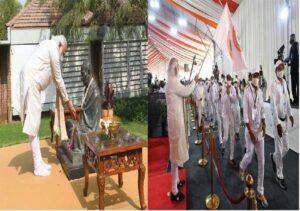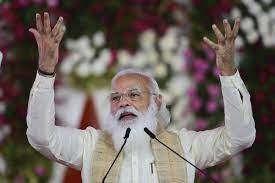On 15 August 2022, India will complete 75 years of being an independent nation. The country has come a long way in terms of development indices, economic growth, literacy, infrastructure development, etc.In December 2021, according to official data, in the July-September quarter of the current financial year (2021-22), India’s economy grew 8.4 per cent, making it the fastest expansion among major economies of the world. This happened with the revival of government spending and private consumption as, over time, the disruptions caused by the Covid-19 pandemic eased out.
On 12 March 2021, India’s Prime Minister Narendra Modi flagged off a ‘Padyatra’ (Freedom March) from Sabarmati Ashram in Ahmedabad, Gujarat and inaugurated the curtain raiser activities of the ‘Azadi Ka Amrit Mahotsav’, also known as, India@75 initiative. At the occasion, several other dignitaries were present including Gujarat Governor Acharya Devvrat, Union MoS (I/C) Prahlad Singh Patel, the then Chief Minister of Gujarat Vijay Rupani and several Gandhi Ashram trustees.
The significance of India@75
Azadi Ka Amrit Mahotsav is an initiative of the Government of India to ‘celebrate and commemorate 75 years of progressive India.’ In March 2021, when the Prime Minister inaugurated the 75 th year celebrations, he addressed the gathering at Sabarmati Ashram and spoke about the significance of the celebrations. At the launch, the PM said that the ‘Azadi ka Amrit Mahotsav’ is to begin 75 weeks before 15 August 2022 and will continue till 15 August 2023. Later, Prime Minister Modi paid homage to the Father of the Nation, Mahatma Gandhi, and remembered the great personalities who laid down their lives during the independence movement, for India to gain freedom from the clutches of a foreign rule.
Speaking on the occasion, the Prime Minister explained what the phrase Azadi Ka Amrit Mahotsav means: It means ‘elixir of energy of independence.’ He added that the phrase means elixir of inspirations of the warriors of freedom struggle; elixir of new ideas and pledges and the nectar of Aatmanirbharat.
Furthermore, the Prime Minister reiterated the five pillars that form the basis of the celebrations. These include the Freedom Struggle, Ideas at 75, Achievements at 75, Actions at 75 and Resolves at 75 – as the guiding force for India to keep moving forward and keeping dreams and duties as inspiration.
India’s legacy of self-reliance
It was in 1930 when Mahatma Gandhi initiated the Dandi March or Salt Satyagraha from Sabarmati in Ahmedabad. The twenty-four day march began on 12 March 1930 and lasted till 6 April 1930. The march was a non-violent protest against the British salt monopoly. Union Minister of State (Independent Charge) for Culture Prahlad Singh Patel reiterated how, today, after 91 years, the same soil where Gandhi started the revolutionary Dandi March is completely transformed and India’s journey will now be defined by self-reliance and self-respect.
India has always been a country of self-reliance and new India is more is not just self-reliant but also leading the world and setting an example in terms of peace building, using science and technology for human welfare as in the case of manufacturing and distributing medicines and vaccines around the world, education, legal reforms, etc.
The country is today leading in all development and economic indices and the biggest of economies today want to have a stake in India and be part of the Indian story. The Prime Minister has envisioned that when the nation celebrates the hundredth year of Independence, India’s ‘achievements and cultural glory should be an outshining example before the world.’
A people’s movement
The Azadi Ka Amrit Mahotsav is a public movement and has been being envisioned and planned as a Jan mahostav. All the events, activities and programmes will be organised by citizens and only their participation will make the mahotsav happen and make it a success.
When Azadi Ka Amrit Mahotsav was launched at Sabarmati, the-then Chief Minister of Gujarat Vijay Rupani expressed his gratitude to the Prime Minister for initiating the movement and the celebrations from Gujarat. Dandi March was an important milestone in India’s history and was a people’s movement too at the same time.
Participation of citizens made the march a success and, along the same lines, the Azadi Ka Amrit Mahotsav is being organised to ensure public participation and involvement.
Gujarat gave India two important members of the country’s freedom struggle who played a pivotal role in the independence movement – Mahatma Gandhi and Sardar Patel. And now, with the people-centric Azadi Ka Amrit Mahotsav celebrations, the nation is fast pacing in the direction of asserting its position as the world leader.
Remembering the ‘freedom fighters’
It’s important to understand the past to be able to plan the future. With the launch of the Azadi Ka Amrit Mahotsav, Prime Minister Modi gave Indians a chance to remember and to pay tribute to all the freedom fighters, movements, uprising and struggles of the freedom movement. He paid homage to those whose contributions, in the country’s freedom struggle and in making India what it is today, have not been duly recognised or documented the way they should have been.
The Prime Minister said that ‘each and every struggle and fight was India’s strong declaration of the truth against the forces of falsehood, a testimony to India’s independent temperament.’ The struggles faced by the nation represented the same consciousness and valour which was present in the ‘days of Lord Ram, during the battle of Kurukshetra in Mahabharat, in Haldighati even the roar of Veer Shivaji.’
The Prime Minister quoted several movements that have been completely ignored in the decades following the country’s Independence. He recalled the Ramoshi, Kol, Khasi, Naga, Santhal, Bhil, Sanyasi, Kittur movement, Travancore movement, Bardoli Satyagrah, Sambhalpur, Kuka, Chuar, Bundel uprisings and movements. These and many more such struggles kept the flame of freedom burning in India’s far corners and amid the diverse communities, tribes and groups.
Apart from those directly involved in the freedom struggle, saints such as Chaitanya Mahaprabhu and Shrimant Sankara Dev gave direction to the masses and ensured they don’t lose focus. In the western part of the country, on the other hand, Tukaram, Meerabai, Narsi Mehta, Eknath, Ramdas and then, in the North, Goswami Tulsidas, Soordas, Kabirdas, Guru Nanak Dev took up the mantle to guide the masses. In the southern part of the country, it was Ramanujacharya, Madhvacharya, Nimbarkacharya and Vallabhacharya who gave direction to people to channelize their resources for the larger good of their brethren and the nation.
The PM spoke of how the Sikh Guru tradition energised the country for protection of its culture and traditions. He emphasised that one should not forget the relentless work and contribution of our saints, mahants and acharyas in every part of the country that formed the stable foundation of the national struggle for freedom and independence.
During the Bhakti period also many spiritual and social leaders inspired masses to ‘reform’ and grow. They were responsible for spreading India’s freedom struggle to all the parts of the country and make it a pan-India movement. There is a pending need to make the people of the country aware of the lives and stories of these leaders. It’s only with these inspiring stories that the present and future generations will know of the sons and daughters who shaped India to what it is today.



